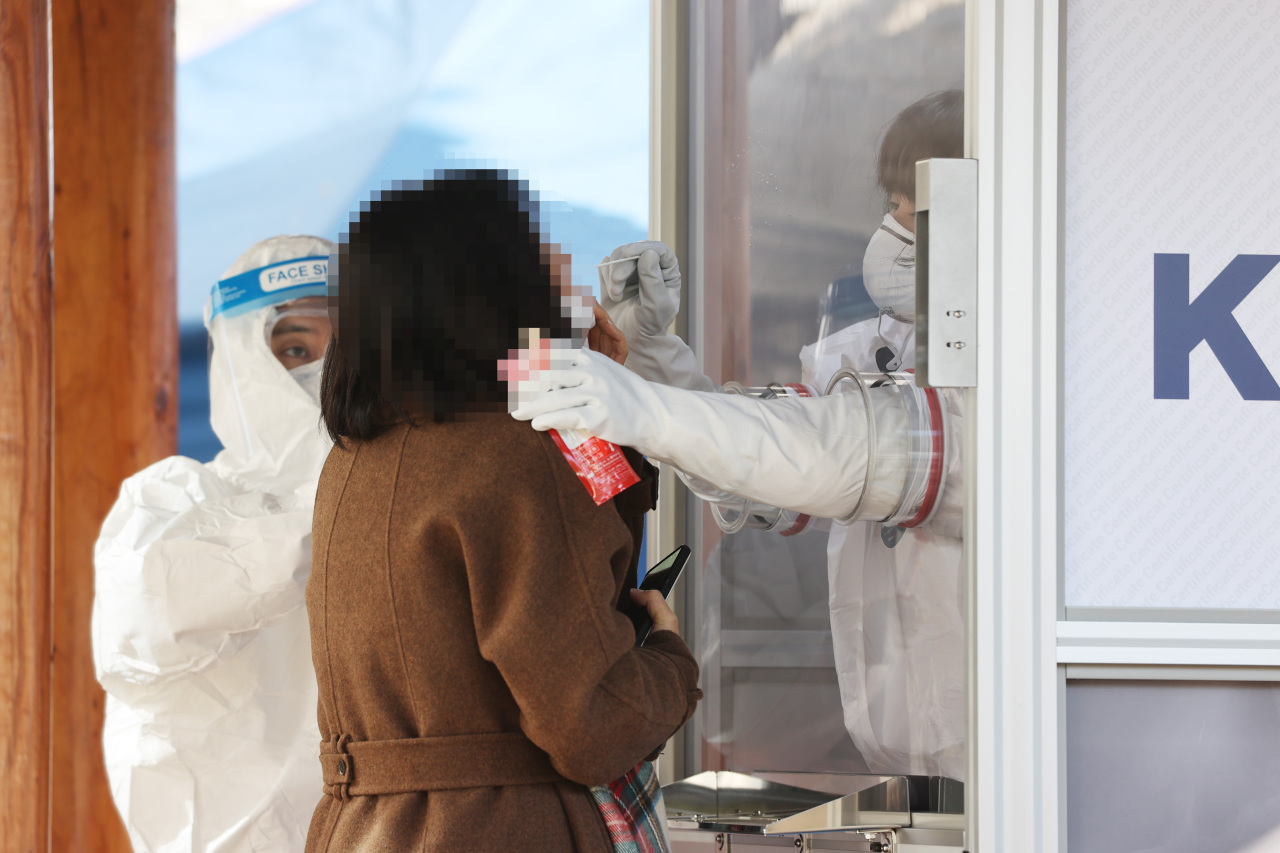Top South Korean health officials on Monday said months of hard work could crumble into nothing if the country fails to contain the latest wave of novel coronavirus infections, calling it the biggest challenge faced by the country since the disease first emerged here.
The Korea Disease Control and Prevention Agency’s chief Jung Eun-kyeong said in a news briefing that the daily case count could surge to 700-1,000 in a week or two based on the latest epidemiological analysis.
“As community transmissions run rampant, two essential rules to follow are: Getting tested when you feel sick with suspected symptoms, and minimizing your chances of exposure by avoiding gathering in the first place,” she said.
Jung once again urged against gatherings of all sizes this winter. “This includes year-end, new year parties and Christmas celebrations.”
Korea on Monday reported 438 cases -- 414 locally transmitted and 24 imported -- detected in the last 24 hours ending Sunday at midnight, the KDCA data showed. Last week, the seven-day average of cases linked to community transmission was 438.7 cases, up 144.5 from the week prior.
Nineteen people have died in the past seven days, with the death toll now reaching 526 and the fatality rate 1.54 percent.
The cumulative total of official cases was changed from the previous day’s 33,824 to 34,201, as a combined 61 cases were deducted from Nov. 18-20’s midnight tallies due to “false positives and other corrections from subsequent investigations,” the KDCA told reporters.
The number of isolated patients with COVID-19 in Korea has risen past 6,000 to near the highest total during the first wave on Monday, according to the KDCA, sparking concerns about a shortage of hospital beds.
All COVID-19 patients in Korea are treated in isolation either at hospitals or nonhospital treatment centers depending on the severity of their symptoms at the time of diagnosis. Latest Ministry of Health and Welfare data shows bed occupancy rates are high at both facilities.
As of Sunday afternoon, 58.9 percent of the 4,479 beds for COVID-19 patients at hospitals across the country had been filled, leaving 1,840 beds available. At 16 nonhospital treatment centers for housing patients with mild illness, 62.3 percent of the 3,478 beds had been occupied, with free beds numbering 1,310.
This is despite the revisions to guidelines for patient management that were made in June, with the purpose of freeing up more beds by reducing the length of stay in care. The National Medical Center’s committee for clinical management of emerging infectious diseases had advised such changes as the surge of patients in the capital area began straining the country’s health care systems.
All COVID-19 beds in Busan have been filled, city officials said over the weekend, and other major cities say their hospitals are struggling to cope with the steep increase in the number of patients.
Full hospital beds forced Busan to implement the most restrictive tier of social distancing system to come into effect immediately until Thursday when Suneung -- the national college entrance exam -- takes place.
Meanwhile the government on Sunday decided not to assign a more restrictive tier in the capital, citing other negative effects of the social distancing measures.
Experts point out Korea has failed to augment health care system capacity over the last 10 months in spite of repeated warnings and numerous opportunities.
Respiratory disease specialist Dr. Chun Eun-mi of western Seoul’s Ewha Womans University Medical Center said Korea’s approach to dealing with health care shortages so far has been “using existing beds more sparingly without actually adding more, by releasing patients earlier.”
“We are discharging patients as their estimated infectivity declines rather than when they recover -- a criteria that can overlook the patients’ readiness or fitness for discharge from care,” she said, warning of potential long-term health consequences that these prematurely discharged patients may face.
Dr. Hong Sung-jin, a former president of the Korean Society of Critical Care Medicine, said during a recent roundtable talk organized by the National Academy of Medicine of Korea that, “While the government had unveiled plans for expanding critical care capacity several times over the last months, not much was executed in practice.”
“Medical societies have said since the onset of the coronavirus crisis that critical care surge strategies were at the core of preventing the health care systems from becoming overwhelmed. But a year later, hospitals are still struggling from the same challenges that were reported during the first surge,” she said.
Infectious disease specialist Dr. Lee Jacob said at the same event Korea was “one nursing home outbreak short of a collapse.”
“If another outbreak occurs at a long-term care home and at-risk patients are infected en masse, that could lead to ICUs filling up more rapidly than at the predicted pace.”
By Kim Arin (
arin@heraldcorp.com)








